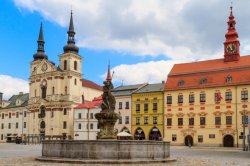Jihlava
Where Moravia clashes with Bohemia, lies the town of Jihlava, the center of the Vysočina region, the oldest upper town in the Czech lands. Currently, Jihlava has more than 50,000 inhabitants and can be found in a picturesque hilly landscape, surrounded by forests and ponds of the Bohemian-Moravian Highlands.
Information for visitors
Interesting facts Jihlava
History of the town
Thanks to the mining of silver ore, this region was colonized relatively quickly, and as early as the end of the 12th century, a Slavic village and the church of St. John the Baptist. Thanks to the silver fever, there were craftsmen, miners and traders not only from the Czech lands, but from all over Europe, for whom, however, a small settlement soon ceased to be enough, so the construction of a new town began on the opposite bank of the river.
Jihlava was founded in about 1240, and thanks to its wealth, three church buildings could be built in the city at the same time. It was the parish church of St. Jakuba, a monastery of Dominicans and minorities. Building regulations of Přemysl Otakar II. it is still noticeable in the regular network of streets and the big square.
Jihlava, as a city, prospered exceptionally and in the very near future was one of the most powerful cities in the kingdom. The defensive function was formed by a massive fortification, stone houses with arcades stood on the square and coinage has been carried out here since 1249. The time of greatest prosperity was the end of the 13th century, when mining took place, construction took place and the population increased. In addition, Jihlava was the first city in Central Europe where, in addition to municipal law, the upper law was also codified, which also created a model for other upper cities. The High Court was also located in Jihlava.
Silver mining slowly ceased to gain in importance until the end of the 14th century, however, the city managed to win the first place not only in this sector, but also in crafts and economy.
In 1523, a fire hit Jihlava, after which the construction of new buildings was carried out in the Renaissance style. However, Jihlava suffered another blow during the Thirty Years' War, when most of the houses were demolished and the suburbs burned down. Only one-eighth of the original population remained here. Further renewal of the city was already taking place in the spirit of the Baroque.
Sights and interesting places in Jihlava
Today, the center of Jihlava is a city monument reserve, combining buildings in the Gothic, Renaissance, Baroque and Classicist styles. The local square is one of the largest in Central Europe and other monuments worth seeing in any case are the city gate of the Mother of God, which is the only gate that has survived of the five medieval city gates in Jihlava, and which also forms the symbol of the city.
The Jihlava underground, whose total area is 50,000 m2, is also a very important monument, making it the second largest underground labyrinth in the Czech Republic. The local catacombs are often spread over two floors and are carved into the rock below the city.
The local zoo offers a pleasant walk.
Author: Andrea Štyndlová

